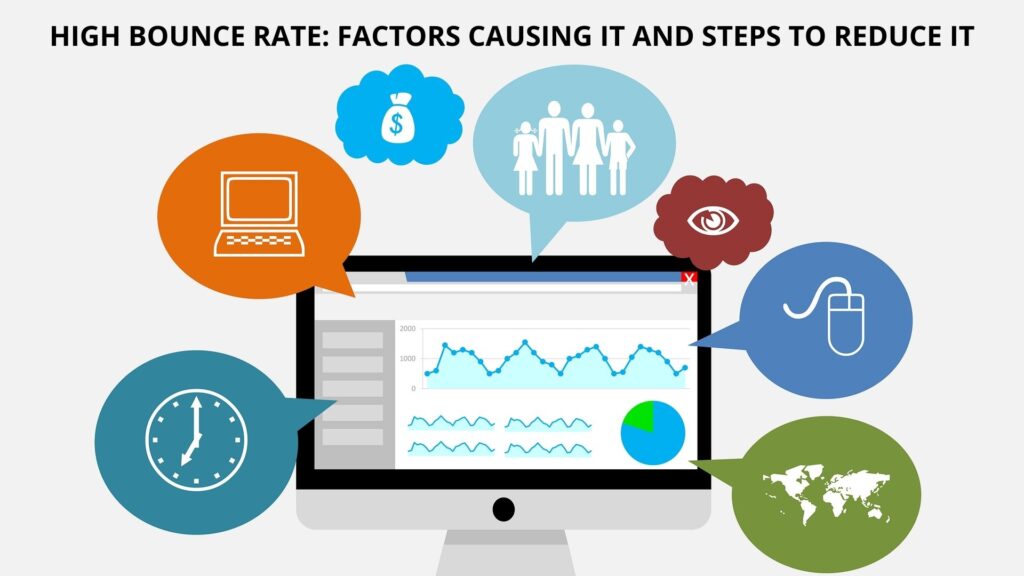Why the bounce rate of your website is high and how can you reduce it? Here’s all you need to know!

Bounce rate refers to the number of people who immediately leave your website as soon as they land on it. While a high bounce rate is essentially not a big problem, it is one unusual move that can lead to a significant drop in conversion. Let’s learn how to reduce bounce rate along with the major reasons that lead to increased bounce rate.
Major Reasons Why The Bounce Rate of A Website is High
The following are the key reasons why the bounce rate of your website could be high.
Bad Quality Content:
If the content of your website doesn’t meet the standards and needs of the webpage visitor, they will be turned off by your website and will try to move forward towards another web page suitable to their requirements. To prevent this, you need to understand the requirements of your webpage visitors and address the shortcomings of your webpage by developing more engaging content that directly connects you to your visitors. Boring or incorrect content will only make your visitors bounce and move somewhere else.
Poor User Experience:
The experience your website gives to the users, in terms of visual appeal and performance, determine the involvement and time spent by the visitor on your webpage. Here, the placement of content, colours, graphics and layout should be well arranged and coordinated, which if not done optimally, can lead to visitors pressing the back button as soon as possible. For this, stick to keeping your website lean with precise content and easy manoeuvrability across sections, by having a simple navigation menu and easy to read the content. Irrelevant images and content can increase the bounce rate of your website.
Technical Errors:
There are chances that the visitors of your webpage might be hitting a roadblock, which can result in high bounce rates despite quality content and a good user experience. These roadblocks might be malfunctioning JavaScript or a plugin gone kaput. Such errors are usually hard to find as they are not visible directly. To check out for such an error, visit your webpage yourself and check the readability of the design, the leanness of the content and any other possible error. If there are such errors, action to improve the root cause must be taken immediately.
Low Speed Issues:
Faster response time and loading speed of your website are also very crucial for enhancing the user experience and reducing its bounce rate. You can check out whether your website is performing optimally fast or not by using tools like GTMetrics, which prepare an analysis of the speed of the website. Further insights can also be obtained with the help of the search console of Google. This can result in even minor improvements, which can result in an increase in the traffic of the website.
ALSO READ: What is Conversion Rate Optimization (CRO)? All Aspects Explained in Detail
Steps to Reduce The Bounce Rate of A Website
Here’s how to reduce bounce rate of website effectively and ensure a longer session duration.
Starting With A Webpage with The Worst Bounce Rate:
Check all the web pages related to your website and find out which one is having the highest bounce rate. This can be done by visiting the webpage like a normal visitor, which will give you insights of the webpage and its performance more clearly. Also, have a look at the design and content of the webpage and revise them if necessary.
Installing A Recording Tool:
This can be done to analyze the way people are navigating your website, such as the movement of cursors by them on your webpage and clicking actions performed by them. Such kind of recording action by a tool can find out the scope of improvements from the part of the user and their behavioral pattern on the webpage.
Running A Heatmap:
Heatmaps are one of the most significant tools to find out what actions the visitors are precisely performing on your website and which part of the website is witnessing the most amount of engagement. This can help you in finding out the most optimal position to place a call-to-action button and reduction in bounce rates of your website.
ALSO READ: How to Reduce Server Response Time
Analyzing The Data:
After finding out which part of the website is witnessing the most amount of engagement or disengagement from the part of the user, you can make out the adjustments to your webpage. The adjustments can be done to the content, images, call-to-action buttons or other elements which are responsible for conversion between the visitor and you.
Conducting A/B Testing:
There are a number of tools for website optimization which facilitate the process of A/B testing, which can help you out in testing the elements of a website in real-time. The A/B testing helps you to get the right combination of elements that carry out improved conversions and reduce bounce rates at the same time.
Implementation of Optimization:
After conducting the A/B testing, you can compare the before and after performance of the webpage and then check the engagement of visitors on your webpage. This can help you out in analyzing the change in behaviour of the visitors. For this, you need to extract the proper amount and quality of data to avoid making rash and impulsive decisions which can result in an increase in bounce rates.
Hope you like this article on how to reduce bounce rate. Stay tuned to The Seo Globe to read more on SEO, SEM, Social Media, User Experience, and other detailed posts on digital marketing.
ALSO READ: Best Tools Available For Conversion Rate Optimization (CRO) in 2022

